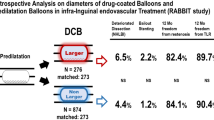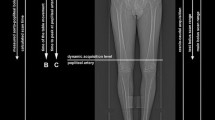Abstract
Acute limb ischemia is a critical condition with high mortality and morbidity even after surgical or endovascular intervention. Early recognition is important, but a delayed presentation is not uncommon. Viability of the limb is assessed by motor and sensory function and with interrogating Doppler flow signals in pedal arteries and popliteal veins as categorized by Rutherford. Category IIa indicates mild-to-moderate threat to limb salvage over a time frame without revascularization. Limb ischemia is critical without prompt revascularization in category IIb. Because the risk of reperfusion injury is high in this group of patients, perioperative management is important. In category III, reperfusion is not indicated except for embolism within several hours of onset. Intimal injury should be avoided by careful tactile control of a balloon with a smaller size catheter and under radiographic monitoring. Adjunctive treatment with catheter-directed thrombolysis or bypass surgery is sometimes necessary. Endovascular treatment is a promising option for thrombotic occlusion of an atherosclerotic artery. Ischemia-reperfusion injury is a serious problem. Controlled reperfusion with low-pressure perfusion at a reduced temperature and use of a leukocyte filter should be considered. The initial reperfusate is hyperosmolar, hypocalcemic, slightly alkaline, and contains free radical scavengers such as allopurinol. Immediate hemodialysis is necessary for acute renal injury caused by myoglobinemia. Compartment syndrome should be managed with assessment of intra-compartment pressure and fasciotomy.


Similar content being viewed by others
References
Norgren L, Hiatt WR, Dormandy JA, Nehler MR, Harris KA, Fowkes FG, TASC II Working Group. Inter-Society Consensus for the Management of Peripheral Arterial Disease (TASC II). J Vasc Surg. 2007;45 Suppl S:S40–47.
Haimovici H. Arterial embolism of the extremeities and technique of embolictomy. In: Haimovici H, editor. Vascular surgery; principle and techniques, 2nd ed. Norwalk: Appleton-Century-Crofts; 1984. pp 351–378.
Haimovici H. Peripheral arterial embolism. A study of 330 unselected cases of embolism of the extremities. Angiology. 1950;1:20–45.
Paaske WP, Sejrsen P. Microvascular function in the peripheral vascular bed during ischaemia and oxygen-free perfusion. Eur J Vasc Endovasc Surg. 1995;9:29–37.
Beyersdorf F, Unger A, Wildhirt A, Kretzer U, Deutschländer N, Krüger S, et al. Studies of reperfusion injury in skeletal muscle: preserved cellular viability after extended periods of warm ischemia. J Cardiovasc Surg (Torino). 1991;32:664–76.
Henke PK. Contemporary management of acute limb ischemia: factors associated with amputation and in-hospital mortality. Semin Vasc Surg. 2009;22:34–40.
Rutherford RB, Baker JD, Ernst C, et al. Recommended standards for reports dealing with lower extremity ischemia: revised version. J Vasc Surg. 1997;26:517–38.
El-Gengehe AT, Ammar WA, Baligh Ewiss E, Ghareeb Mahdy S, Osama D. Acute limb ischemia: role of preoperative and postoperative duplex in differentiating acute embolic from thrombotic ischemia. Cardiovasc Revasc Med. 2013;14:197–202.
Romero J, Cao JJ, Garcia MJ, Taub CC. Cardiac imaging for assessment of left atrial appendage stasis and thrombosis. Nat Rev Cardiol. 2014;11:470–80.
Rutherford RB1, Baker JD, Ernst C, Johnston KW, Porter JM, Ahn S, Jones DN. Recommended standards for reports dealing with lower extremity ischemia: revised version. J Vasc Surg. 1997;26:517–38.
Fogarty TJ, Cranley JJ, Krause RJ, Strasser ES, Hafner CD. A method for extraction of arterial emboli and thrombi. Surg Gynecol Obstet. 1963;116:241–4.
Forgaty T. Historical reflections on the management of acute limb ischemia. Semin Vasc Surg. 2009;22(1):3–4.
Babu SC, Shah PM, Nitahara J. Acute aortic occlusion—factors that influence outcome. J Vasc Surg. 1995;21:567–75.
Plecha FR, Pories WJ. Intraoperative angiography in the immediate assessment of arterial reconstruction. Arch Surg. 1972;105:902–7.
Armon MP, Yusuf SW, Whitaker SC, Gregson RH, Wenham PW, Hopkinson BR. Results of 100 cases of pulse-spray thrombolysis for acute and subacute leg ischaemia. Br J Surg. 1997;84:47–50.
Ouriel K, Shortell CK, DeWeese JA, Green RM, Francis CW, Azodo MV, Gutierrez OH, Manzione JV, Cox C, Marder VJ. A comparison of thrombolytic therapy with operative revascularization in the initial treatment of acute peripheral arterial ischemia. (Rochester study) J Vasc Surg. 1994;19:1021–30.
Weaver FA, Comerota AJ, Youngblood M, Froehlich J, Hosking JD, Papanicolaou G. Surgical revascularization versus thrombolysis for nonembolic lower extremity native artery occlusions: results of a prospective randomized trial. The STILE Investigators. Surgery versus thrombolysis for ischemia of the lower extremity. J Vasc Surg. 1996;24:513–21.
Ouriel K, Veith FJ, Sasahara AA. A comparison of recombinant urokinase with vascular surgery as initial treatment for acute arterial occlusion of the legs. Thrombolysis or Peripheral Arterial Surgery (TOPAS) Investigators. N Engl J Med. 1998;338:1105–11.
van der Slegt J, Flu HC, Veen EJ, Ho GH, de Groot HG, Vos LD, van der Laan L. Adverse events after treatment of patients with acute limb ischemia. Ann Vasc Surg. 2015;29:293–302.
Lurie F, Vaidya V, Comerota AJ. Clinical outcomes and cost-effectiveness of initial treatment strategies for nonembolic acute limb ischemia in real-life clinical settings. J Vasc Surg. 2015;61:138–46.
Setacci C, DeDonato G, Setacci F, Sirignano P, Galzerano G. Hybrid procedure for acute limb ischemia. J Cardiovasc Surg. 2012;53(Suppl):133–43.
Ouriel K, Veith FJ. Acute lower limb ischemia: determinants of outcome. Surgery. 1998;124:336–41.
Eliason JL, Wakefield TW. Metabolic consequences of acute limb ischemia and their clinical implications. Semin Vsac Surg. 2009;22:29–33.
Beyersdorf F, Matheis G, Kruger S, et al. Avoiding reperfusion injury after limb revascularization: experimental observations and recommendations for clinical application. J Vasc Surg. 1989;9:757–66.
Schmidt CA, Rancic Z, Lachat ML, Mayer DO, Veith FJ, Wilhelm MJ. Hypothermic, initially oxygen-free, controlled limb reperfusion for acute limb ischemia. Ann Vasc Surg. 2015;29:560–72.
Beyersdorf F, Mitrev Z, Ihnken K, et al. Controlled limb reperfusion in patients having cardiac operations. J Thorac Cardiovasc Surg. 1996;111:873–81.
Beyersdorf F, Schlensak C. Controlled reperfusion after acute and persistent limb ischemia. Semin Vas Surg. 2009;22:52–7.
Modrall JG. Compartment syndrome. In: Cronenwett JL, Johnston KW, editors. Rutherford’s vascular surgery, 7th ed. Philadelphia: Saunders; 2010. pp 2412–21.
Davey JR, Rorabeck CH, Fowler PJ. The tibialis posterior muscle compartment. An unrecognized cause of exertional compartment syndrome. Am J Sports Med. 1984;12:391–7.
Acknowledgments
A part of this review was presented at the Postgraduate Course of the 67th Annual Meeting of the Japanese Association for Thoracic Surgery.
Author information
Authors and Affiliations
Corresponding author
Ethics declarations
Conflict of interest
None.
Additional information
This review was submitted at the invitation of the editorial committee.
Rights and permissions
About this article
Cite this article
Fukuda, I., Chiyoya, M., Taniguchi, S. et al. Acute limb ischemia: contemporary approach. Gen Thorac Cardiovasc Surg 63, 540–548 (2015). https://doi.org/10.1007/s11748-015-0574-3
Received:
Published:
Issue Date:
DOI: https://doi.org/10.1007/s11748-015-0574-3




